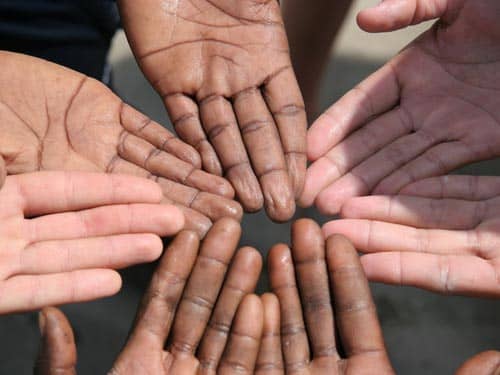But each has embraced a principle author Jon M. Sweeney believes needs resuscitating in modern worship practices: God not only wants your soul, but your body as well.

| ||
| Embodied prayer is "one of the purer forms of spirituality." | ||
 |
"The involvement of the body in worship has been de-emphasized to the point that the way we practice worship in many congregations is that prayer is supposed to be vocal or mental, in the head," said Sweeney, who included those photographs in his book "Praying With Our Hands: 21 Practices of Embodied Prayer from the World's Spiritual Traditions." The book chucks the notion that the body is a spiritual stumbling block. "Hopefully we can take a small step toward correcting that."
Many believers take that step every day--albeit unwittingly, Sweeney said. When receiving Holy Communion, igniting Sabbath candles, counting rosary beads or bowing their heads to say grace before a meal, believers are unconsciously meshing the physical and spiritual, giving both roles in spiritual practice.
Too often prayer is considered strictly a mental activity, but enthusiasm for physical expression in worship hasn't faded entirely, Sweeney said, pointing to the growing popularity of liturgical dance.
"That's a good example of a setting--at least in Christianity--where the body was not forgotten but was seen as a real vehicle for spiritual meaning," he said.
Embodied prayer even extends to a practice less often associated with worship--begging, Sweeney said.
"Begging is a sort of prayer with the hands--people in a lot of different religious traditions have used begging as part of their religious practices," Sweeney said. "And the way in which we relate to beggars says a lot about our own spirituality."
Embodied prayer is "one of the purer forms of spirituality," said Sweeney, who first stumbled upon the concept while reading a biography of the Buddhist monk Thich Nhat Hanh. In the book, the monk says one of the greatest lessons he learned during his first year in a monastery was the art of opening and closing doors quietly.
That concept crosses the religious spectrum, Sweeney said.
"In many ways, spiritual traditions are a part of each other, and that's important to show," Sweeney said. "I think in the future it will seem perfectly natural to be involved in one religious tradition but benefit from the spiritual practices of other religious traditions."

| ||
| "We have to start to be conscious and mindful of what we do with our hands..." | ||
 |
Even so, the idea is not strictly the province of religion, said Sweeney, noting that his book includes photographs of a woman and man practicing the "spiritual grace" of hospitality by breaking bread.
In another photograph, the raised arm of a protester is accompanied by text that notes "we pray with our bodies when we put them in front of tanks. We pray with our hands when we link arms to fight injustice. We are co-creators with the Divine when we resist evil. The world is more sacred at these moments."
"Embodied prayer has so little to do with dogma," Sweeney said. "A lot of it certainly doesn't fit within any religious tradition, and it's practiced by people who don't think of themselves as spiritual."
The concept shows people how to "look at their hands anew," Sweeney said.
"We have to start to be conscious and mindful of what we do with our hands," he said. "You have to decide whether they will bring greater hope and love into the world or do things that bring damage and difficulty to the world."

